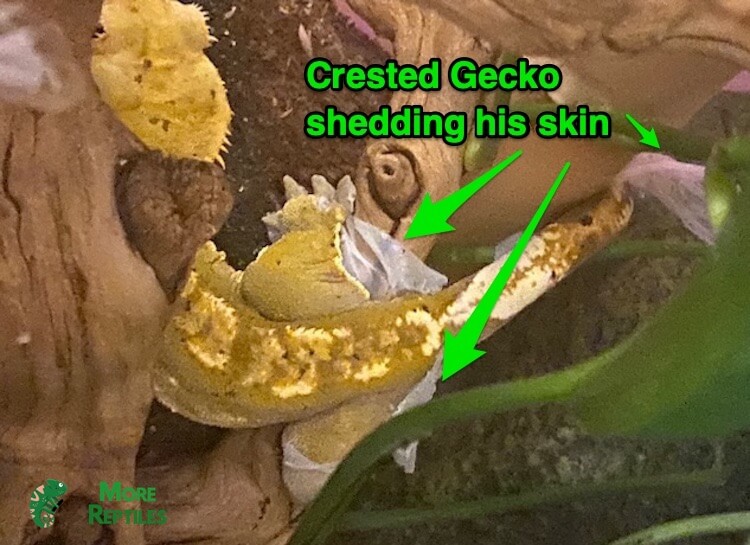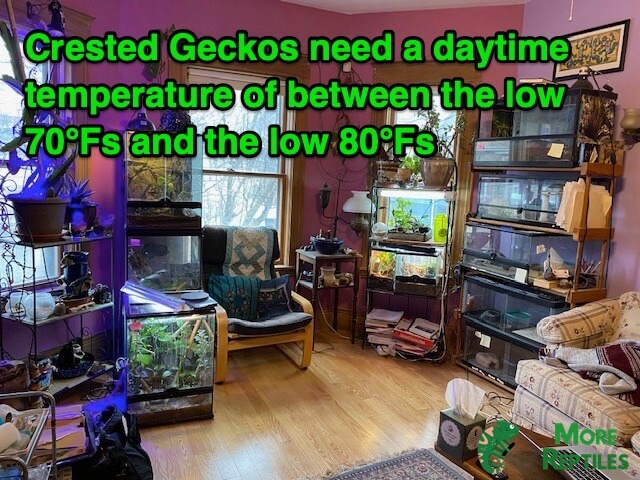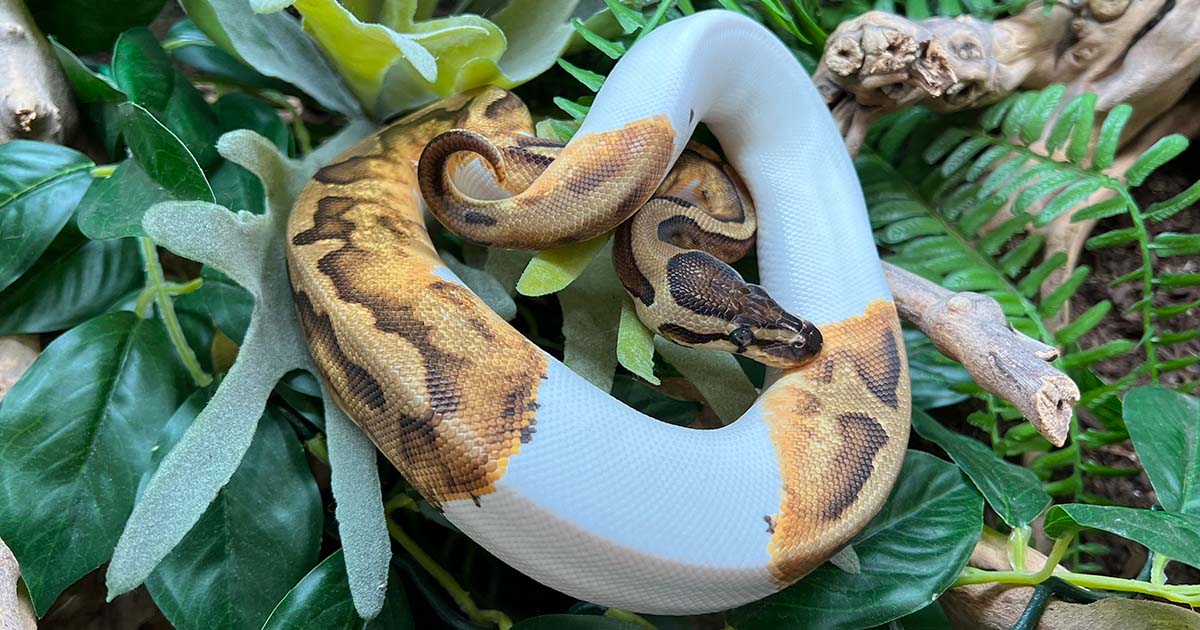All reptiles shed their skin, even Crested Geckos.
A Crestie that’s getting ready to shed may have a “frosty” appearance. This is because the top layer of skin pulls away from the body.
When a Crested Gecko sheds, sheets of white skin peel away from its body. Occasionally, there may be pieces of thin white skin hanging from their tail or feet.
Since Cresties live in a humid environment, it is unusual for them to have difficulty shedding. But, to be a good keeper, you need to learn about shedding and whether or not you need to help them.
Key Takeaways
- Crested Geckos shed their skin as they grow bigger because it doesn’t grow with them.
- Shedding helps heal injuries as it refreshes the protective outer layer of skin.
- Most adults shed every 6-8 weeks. Hatchlings and juveniles may shed more often as they are growing quickly, sometimes every week or two.
- You can tell that a Crested Gecko is shedding because it will have sheets of white skin peeling away from its body.
- Most Cresties completely shed within a few hours. If they have stuck shed after 24 hours, it is a good idea to help them out.
Crested Gecko Shedding

Crested Geckos live in the island rainforests of New Caledonia with a relatively high humidity. This humid environment makes it much easier for them to shed when compared with species in a more arid environment like Leopard Geckos.
Related: Leopard Gecko Shedding 101: Symptoms, Problems & Behavior
What Is It
Crested Geckos shed to accommodate their growth and to refresh the protective outer layer of skin
When they are getting ready to shed, they may have a “frosty” appearance, where it seems as if their body has a white translucent coating. Occasionally, there may be pieces of thin white skin hanging from its tail or feet.
It is likely that within the couple of hours, the Gecko will shed and look “normal” again.
Most complete the shedding process within a few hours by rubbing against rough surfaces in the enclosure and by biting at the shed with their teeth and pulling it off.
Some keepers may almost never see their Crested Gecko shedding since it happens so easily and quickly.
Sometimes you may not even know that they have shed, or you may wonder why he looks so strange one day, and then “normal” the next day.
I wish I could tell you exactly how often mine shed. However, based on my experience, I rarely notice them shedding since it happens quickly and completely. It is said adults shed every 4-6 weeks, but you may not see them shedding that often since they often shed quickly and at night.
Author Tip: Some beginners wonder why their Crested Gecko never seems to shed. The answer is likely that they are shedding, but it always happens at night when the keeper isn’t around.
I have never seen any of mine eating their shed, but on the other hand I’ve never found a complete shed in the cage! I can only conclude from this that they must eat at least some of it.
It is not unusual for me to check my Crested Geckos in the morning and find a tail-shaped piece of shed at the bottom of the cage. Apart from that, I’m rarely aware that they have shed.
This almost never happens with my Leopard Geckos as it can take a day for them to shed and they often have big piece of shed attached to its head, feet or tail.
In rare situations, a Crested Gecko may have difficulty shedding too.
In these circumstances they will need some “help” from the keeper. The sections below list some common issues and when action needs to be taken by the keeper and when nothing needs to be done.
What To Do
90{a47be734f0df8d7f120a7df290cf380c79376e8356d1aab405383bb23aa6ce67} of the time a Crested Gecko is able to shed properly without the help of a keeper.
What about the other 10{a47be734f0df8d7f120a7df290cf380c79376e8356d1aab405383bb23aa6ce67} of the time?
When you notice skin hanging from their body, this means shedding has begun.
Check again a day later, if there is still skin hanging, this is a sign that they need some help from you…
The best solution is to put your gecko in a “sauna”.
Grab a round or square plastic container that is large enough for them. Then cut a hole in the top and place several layers of paper towel inside the container and moisten it with warm water. Put the gecko in this warm, humid box for at least five minutes and then let it out.

If using a sauna is not successful, give it another try.
You can use a sauna three times per day!
You can also help by misting once more in the mornings to increase humidity to around 80{a47be734f0df8d7f120a7df290cf380c79376e8356d1aab405383bb23aa6ce67}.
Author Tip: It is always a good idea to give your Crested Gecko a day to complete the shed on its own. After that, if there’s still shed, you can help.
On occasion, a Crested Gecko’s shed may not coming off in sheets, it can appear that the skin is coming off in small flakes and is more tightly stuck than usual.
It does look a lot like a terrible case of dandruff!
It is not unusual for a Crested Gecko to have a “messy” shed. However, if it frequently takes a long time to shed and needs help, there may be other issues contributing to the difficulty.
The most common reason is not enough humidity in the tank.
Some enclosures don’t hold humidity well, despite daily misting.
An appropriate enclosure has a humidity of between 60-80{a47be734f0df8d7f120a7df290cf380c79376e8356d1aab405383bb23aa6ce67} and a water dish, which helps to maintain humidity. The best setups also have plants, which help to keep the humidity high.
If your enclosure doesn’t have plants, and you don’t want to plant anything directly into the substrate, you can put small potted plants in the cage. Pothos are a good choice, they thrive in high humidity and can easily occupy empty vertical space.
You can read more about easy and safe plants in our Crested Gecko plant guide.
Another reason for poor shedding is dehydration.
Dehydration occurs when a Crested Gecko doesn’t drink enough and ends up without enough liquid. This is usually more of a symptom than the problem. When properly cared for, they should live in an environment with good access to water and high humidity.
Signs of dehydration include:
- Weakness
- Sunken eyes
- Difficulty shedding
You can encourage your Crested Gecko to drink by misting the cage next to their head. This will make it easy for them to lick up the water drops.
My Crested Geckos often enjoy these water droplets and can be seen licking up the drops while the misting is going on. If this doesn’t work, you can try dripping water on their nose with an eyedropper.
If yours won’t drink and continues to have difficulty shedding, it is a good idea to make an appointment with a reptile vet.
Before taking it to a vet, make sure the temperature and humidity levels are right.
Types of Shed
Most Crested Gecko skin does not come off in a single piece like that of a snake. After all, they are a bit more complicated in shape than a snake.
Geckos are usually able to pull their skin off in sheets by biting it or rubbing against a rough surface. This can include cage furniture, climbing perches or even the background of the enclosure if one is there.
Shedding alone encourages natural behaviors, since in the wild there’s no one there to help them. It is also important mental stimulation for them.
On occasion, they can’t get the shed off completely
Sometimes the shed remains on their head, tail or toes.
Masked Man
If you see your Crested Gecko with the “masked superhero” look, they have a piece of stuck shed on their face! This isn’t rare, as they can’t really use teeth to pull off the shed on their head.
Most will be dependent on being able to rub their head against a rough surface in order to loosen and remove the shed.
If the stuck head shed is still there after a day, feel free to offer a suana and misting.
Author Tip: Do not try to pull off stuck shed with fingernails or tweezers, this can cause trauma to the skin layer below.
Gloved Up
As Crested Geckos shed, loose skin may come off in small pieces or in flat sheets, especially the shed skin from their back, sides and belly. The narrower body parts are often peeled off intact.
Sometimes you will find a tail-shaped piece of shed in the cage.
The most interesting find is when the gecko sheds the skin on its foot and leg in one piece and leaves it in the cage. It looks like a glove!
Stuck Feet

If your Crested Gecko is spending a lot of time on the bottom of the cage, he may have some pieces of shed on his feet or toes (as seen in the picture above).
This stuck shed will make it hard for them to climb the sides of the cage.
Hold your gecko gently and examine the toes for small pieces of whitish skin that seems to be peeling off. Moisten the area with a spray bottle and see if you can gently remove these pieces of shed.
If you don’t see any pieces of shed on his feet, and he is still having trouble climbing, he may have Metabolic Bone Disease. Geckos with MBD are weak and often have rubbery or misshapen limbs or spine which makes it hard for them to pull off their shed and climb.
Fired Up

Crested Geckos vary in color over the span of 24 hours.
When they are sleeping, or at rest, they tend to be a pastel or drab color. This is called being “fired down”. When they are awake and active (or if they become upset), they “fire up” and become brighter.
One of my geckos is pale tan when “fired down” and becomes red when “fired up”.
You may notice on occasion that your Crested Gecko looks paler than usual when fired down, this is most likely because they are getting ready to shed.
When they are actively getting ready to shed, the old skin begins to peel away from the body. Since there is a little space between the old skin and the body, the old skin appears to be whiter than usual.
Don’t worry, it is likely that within 24 hours it will return to its normal color again.
Cloudy Eyes
Not only do Crested Geckos lick their eyeballs to clean them, but they also have a clear film over their eyes.
When Crested Geckos shed, this clear film also comes off and is replaced by a new film. On occasion, the “eyecap” doesn’t come off entirely and this can cause the eye to look cloudy.
If the eye continues to look cloudy after 24 hours, try dribbling some water on the eye to increase the humidity in that area.
Monitor the eye carefully to see if the cloudy area disappears.
If a stuck eyecap remains for more than a week, don’t attempt to remove it, this will need to be done by a reptile vet. As has been explained to me by a vet, the vet will use a tool with prongs on the end that can grip the tissue and gently pull it out from the eye.




